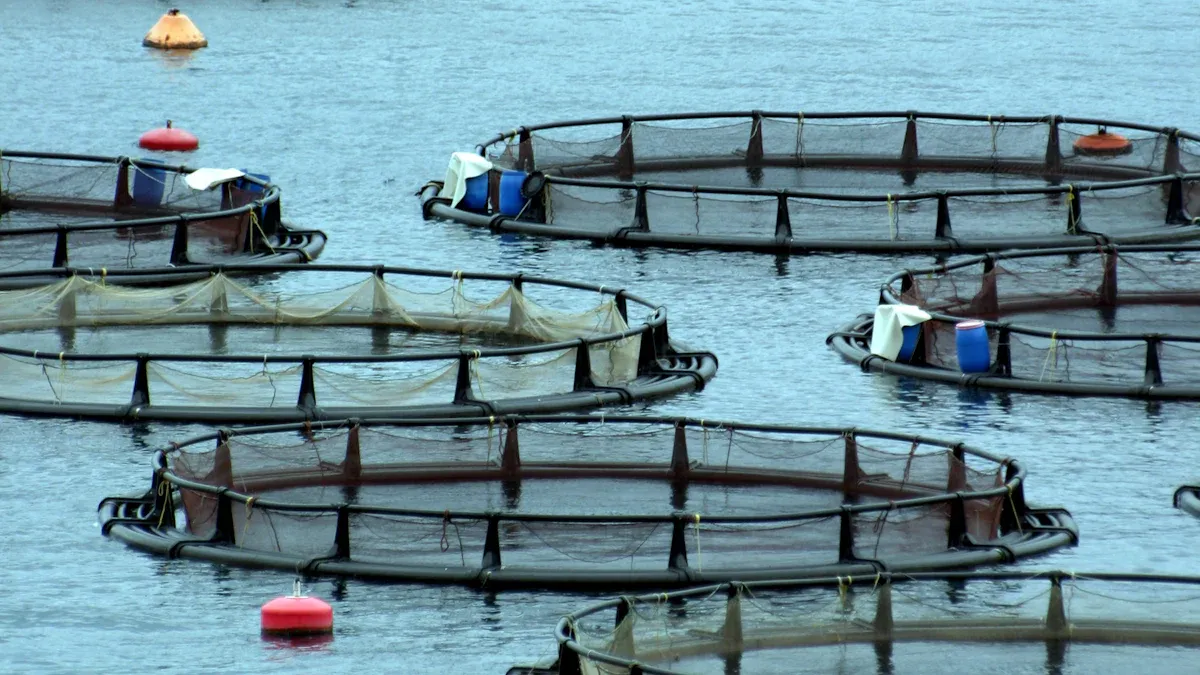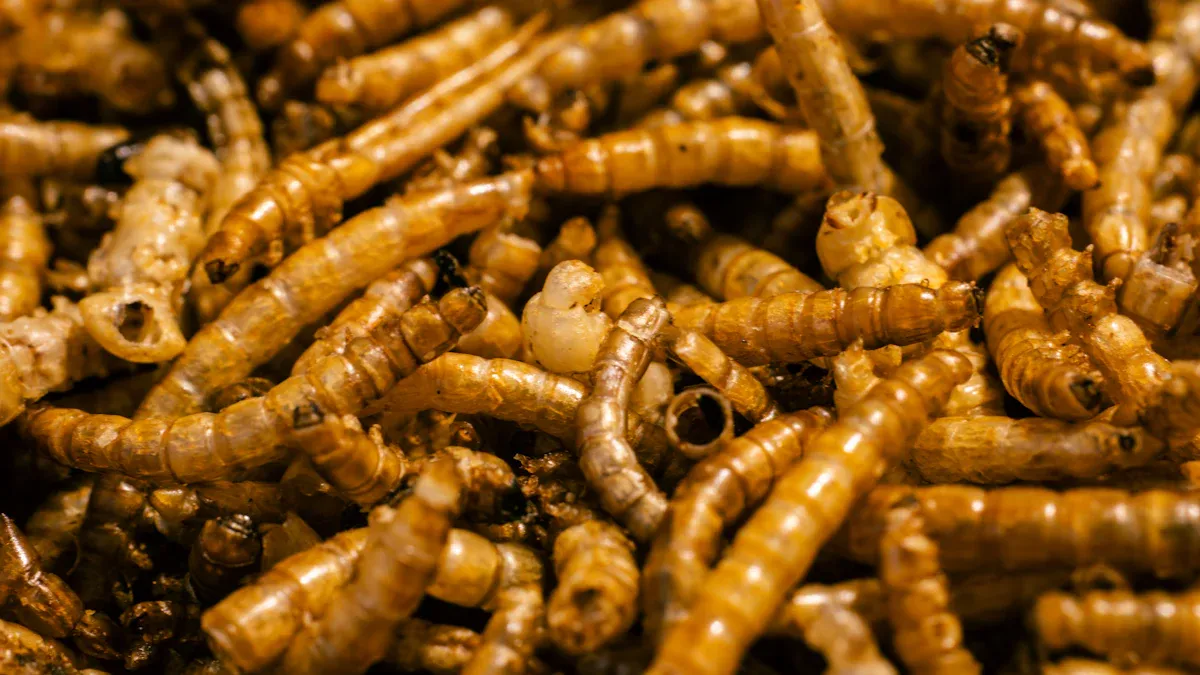
Have you ever wondered how France is tackling sustainability in aquaculture? One surprising answer lies in dried mealworms for fish. These tiny insects pack a punch when it comes to nutrition and eco-friendliness. They use nitrogen more efficiently than cattle and produce fewer greenhouse gases. Plus, they need less land and energy to grow. By replacing traditional feed, mealworms could help French aquaculture reduce its environmental footprint while supporting healthier fish.
Key Takeaways
- Dried mealworms are a greener choice than regular fish feed. They use less water, land, and energy, which helps the environment.
- Mealworms make fish healthier and grow faster. They are full of protein and fat, helping fish grow quickly and absorb nutrients better.
- Using mealworms helps local farmers and businesses. They can be grown nearby, cutting costs and building stronger farming systems.
Challenges in Traditional Aquaculture Feed
Environmental Strain from Fishmeal and Fish Oil
Have you ever thought about where traditional fish feed comes from? Most of it relies on fishmeal and fish oil, which are made from small fish like anchovies and sardines. This puts a lot of pressure on marine ecosystems. Overfishing these forage fish disrupts the food chain, affecting larger marine animals like seabirds and dolphins. Plus, fishmeal often introduces microplastics into the water. These tiny plastic particles harm aquatic life and can even make their way into the seafood you eat. On top of that, uneaten feed and fish waste pollute the water, throwing off the natural balance of local ecosystems.
Overfishing and Resource Scarcity
The demand for fish feed keeps growing as aquaculture expands. But the ocean isn’t an endless resource. Overfishing to produce fishmeal and fish oil has already pushed some fish populations to the brink. This scarcity makes it harder to keep up with the rising demand for feed. It’s a vicious cycle—more aquaculture means more feed, which leads to more overfishing. If this continues, the industry could face serious challenges in maintaining sustainable practices.
Economic Pressures on Feed Supply Chains
You’ve probably noticed how rising costs affect everything these days, and aquaculture is no exception. The growing demand for fishmeal and fish oil drives up prices, putting financial strain on fish farmers. This makes it harder for small-scale farmers to compete. On top of that, contamination from microplastics and nutrient pollution adds extra costs for cleaning up and maintaining healthy environments. Switching to alternatives like dried mealworms for fish could help ease these economic pressures while supporting sustainability.
Advantages of Dried Mealworms for Fish

Superior Nutritional Profile
You might be surprised to learn how nutritious dried mealworms for fish are. They’re packed with essential amino acids, which are the building blocks of proteins. These amino acids are similar to those found in fishmeal and soybean meal, making mealworms an excellent alternative. Studies show that fish fed mealworm-based diets grow faster and digest their food better.
Here’s a quick look at what research says:
| Study | Findings |
|---|---|
| Replacement of soy by mealworms | Mealworms have amino acids similar to fishmeal, improving fish growth. |
| Effect of mealworm on fish performance | Mealworms enhance nutrient use and digestive enzyme activity in fish. |
| Mealworms in feed for Atlantic salmon | Mealworms support growth and protein breakdown in salmon. |
Lower Environmental Impact
Switching to dried mealworms for fish isn’t just good for nutrition—it’s great for the planet too. Mealworms require less water, land, and energy to produce compared to traditional feed. They also emit fewer greenhouse gases.
Take a look at this comparison:
| Metric | Dried Mealworms | Traditional Aquaculture Feed | Comparison |
|---|---|---|---|
| Water Footprint (m3/t) | 4341 | 15000 (Beef) | 3.5 times less than beef |
| Greenhouse Gas Emissions | Lower | Higher | Less ammonia and GHG |
| Land Use (m2/kg) | Less | More | Requires less area |
| Feed Conversion Efficiency | Comparable to chickens | Lower than mealworms | More efficient nitrogen use |
By choosing mealworms, you’re helping reduce the strain on natural resources while supporting sustainable aquaculture.
Boosting Fish Health and Growth
Dried mealworms for fish don’t just help the environment—they also make fish healthier. They’re rich in protein and fat, which are essential for growth. Fish fed mealworm diets show better nutrient absorption and faster growth rates. Mealworms also improve gut health by promoting a diverse microbiota. This means healthier, stronger fish that thrive in aquaculture settings.
| Aspect | Evidence |
|---|---|
| Nutritional Benefits | High protein and fat levels enhance growth and nutrient use. |
| Gut Health | Mealworms improve gut microbiota diversity, leading to better health. |
| Immunological Benefits | Mealworm diets boost immune responses, keeping fish healthier. |
Supporting Gut Health and Immunity
Did you know mealworms can even strengthen a fish’s immune system? Including mealworms in fish diets has been shown to increase anti-inflammatory activity and protect against harmful microbes. This is partly due to chitin, a natural component of mealworm exoskeletons. Chitin stimulates the immune system and helps fish fight off bacterial infections.
Here are some key findings:
- Fish fed mealworm diets showed higher lysozyme activity, which protects against microbes.
- Chitin in mealworms enhances immune responses and reduces inflammation.
- Mealworms may even secrete antimicrobial peptides, offering extra protection.
By improving gut health and immunity, mealworms help fish stay healthy and resilient.
Transforming French Aquaculture with Mealworms

Meeting Sustainability Targets
You might not realize it, but mealworms are helping France hit its sustainability goals in aquaculture. These tiny insects are incredibly efficient at turning organic waste into protein. For every 1.7 kilograms of feed, mealworms produce 1 kilogram of biomass. Compare that to traditional livestock, which can need up to 8 kilograms of feed for the same result. By using dried mealworms for fish, you’re reducing the strain on marine resources by as much as 25%. That’s a big step toward protecting ocean ecosystems.
France is also aligning with the European Union’s Farm to Fork Strategy, which promotes sustainable food systems. The EU is encouraging insect-based feeds, and the market for these is growing by over 20% annually. By adopting mealworms, French aquaculture is leading the way in eco-friendly practices.
Economic Benefits for Local Farmers
Switching to mealworm-based feed isn’t just good for the planet—it’s great for farmers too. Producing mealworms requires less space, water, and energy compared to traditional feed sources. This makes it a cost-effective option for small-scale farmers. Plus, mealworms can be farmed locally, reducing the need for expensive imports.
When you choose mealworms, you’re supporting local economies. Farmers can diversify their income by raising mealworms alongside other crops or livestock. This creates a more resilient agricultural system. It’s a win-win for both the environment and the people who rely on aquaculture for their livelihoods.
Industry-Wide Innovation Potential
Mealworms are sparking innovation across the aquaculture industry. As awareness of sustainable protein sources grows, the demand for mealworm-based feed is skyrocketing. Regulatory support from the EU and organizations like the FAO is making it easier for farmers to adopt insect proteins.
The benefits don’t stop there. Mealworms require minimal resources to produce, making them an efficient and scalable solution for the future of aquaculture. Projections show the mealworm feed market could grow at a rate of over 30% annually, especially in regions focused on sustainability. By embracing this innovative feed option, you’re helping to shape a more sustainable and forward-thinking industry.
Dried mealworms offer a powerful combination of environmental and nutritional benefits. They’re rich in protein and fat, with crude protein levels ranging from 47.2% to 66.3% and crude fat from 14.9% to 43.1%. These nutrients help fish grow faster and stay healthier. Plus, mealworms improve gut microbiota diversity, which boosts fish immunity.
| Comparison Metric | Mealworms | Other Diets |
|---|---|---|
| Growth Performance | Equivalent or improved | N/A |
| Feed Efficiency | No negative effects | N/A |
| Egg Production Ratio | 2.4% higher | N/A |
By adopting mealworms, France is leading the way in sustainable aquaculture. This shift reduces pressure on marine ecosystems and aligns with global sustainability goals. As more countries explore insect-based feeds, mealworms could transform aquaculture worldwide. Imagine a future where fish farming is both eco-friendly and efficient—mealworms make it possible.
FAQ
What makes mealworms a sustainable choice for aquaculture?
Mealworms use fewer resources like water and land. They also emit less greenhouse gas, making them an eco-friendly alternative to traditional fish feed. 🌱
Are mealworms safe for fish to eat?
Yes! Mealworms are FDA-approved and packed with nutrients. They improve fish growth, gut health, and immunity, ensuring your fish stay healthy and thrive. 🐟
Can mealworms replace fishmeal entirely?
Mealworms can replace a significant portion of fishmeal. Studies show they provide similar or better nutrition, making them a viable and sustainable alternative.
Tipp: Switching to mealworms supports both the environment and your aquaculture goals!


